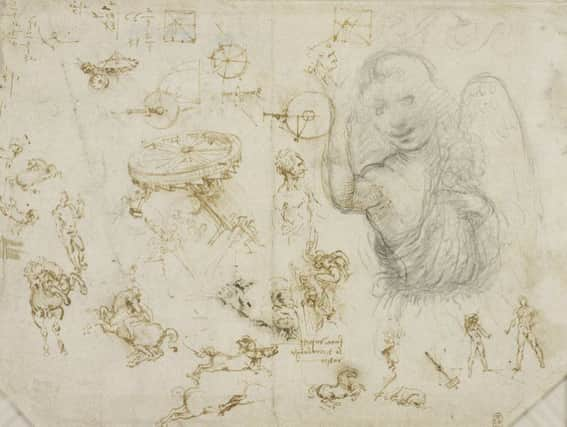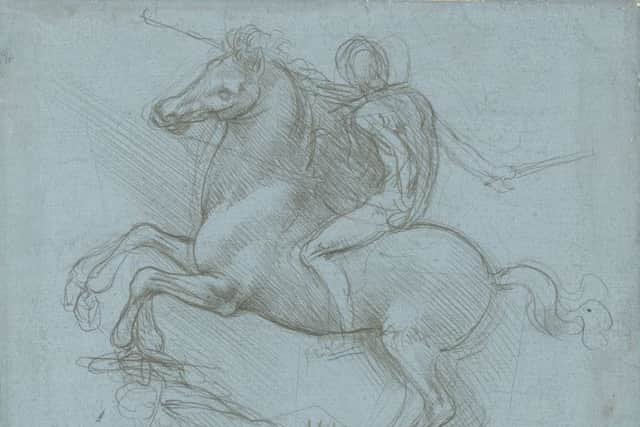Some of Leonardo da Vinci’s greatest drawings have gone on display in Sheffield


He was the leading artist and intellect of the Renaissance, that fervent period of ‘rebirth’ in Europe between the 14th and 17th centuries, and is best known for two paintings – The Last Supper and the Mona Lisa.
Yet da Vinci was far more than just a gifted painter, he was also a mathematician, architect, engineer and inventor. Now, to mark the 500th anniversary of his death, 144 of his greatest drawings have just gone on display in 12 exhibitions across the country, including at Leeds Art Gallery and Sheffield’s Millennium Gallery.
Advertisement
Hide AdAdvertisement
Hide AdEach exhibition – part of Leonardo da Vinci: A Life in Drawing – has 12 drawings which will all be brought together for a later exhibition in the suitably regal surroundings of The Queen’s Gallery at Buckingham Palace at the end of May.


Put together by the Royal Collection, the drawings reflect his interest in everything from architecture and music to anatomy and cartography.
“This is the biggest nationwide Leonardo exhibition that there has been in this country and probably ever will be,” says Martin Clayton, head of drawings for the Royal Collection Trust at Windsor Castle.
Da Vinci was a polymath ahead of his time and the Royal Collection holds some of his greatest works. “We calculate that about 34 million people are within one hour of these Leonardo exhibitions, which is more than half the UK population. “There’s never been anything like this before,” says Clayton.
Advertisement
Hide AdAdvertisement
Hide AdAlong with Michelangelo and Raphael, da Vinci helped change the way paintings looked and the way artists viewed the world. But, as Clayton explains, his scientific studies were just as important as his artistic work. “We’re accustomed nowadays to thinking about art and science as two separate things but Leonardo saw them as one big single pursuit of understanding the universe, and what makes these exhibitions so revealing is that drawing was the way in which he thought.”
For all his brilliance da Vinci had the misfortune to live in Europe at a time when it was engulfed in military and political turmoil and some of his greatest works were either destroyed, or remained unfinished.
“Very little of his sculpture, architecture and engineering survives other than through his remarkable drawings.”
Today, he is recognised as one of the great scientific minds of the Renaissance, yet he had little impact during his lifetime (beyond his art) because his studies remained in his private papers and weren’t properly published until the start of the last century. “For 400 years all these great researches remained in this cache of drawings, of which the most important group is at Windsor and is making up this exhibition in places like Sheffield and Leeds,” says Clayton.
Advertisement
Hide AdAdvertisement
Hide AdDa Vinci’s study of flowing water is among the drawings on display in Sheffield. “It’s one of Leonardo’s greatest drawings. It’s by far the most beautiful and insightful of his studies of flowing water and it shows how Leonardo’s mind worked, and how in the days before photography he was able to almost take a photograph in his mind and get that down on paper with such conviction. He could represent a scene that had never been represented before.”
The drawing of the head of St Philip for The Last Supper is another significant sketch on display in the city. “The Last Supper was Leonardo’s greatest finished work and it’s the greatest of his works that survives today. But how he arrived at this painting is almost unknown. There’s only about half a dozen drawings for it that still exist and this is one of them. And because the painting is such a wreck this drawing allows us to see what it was he was trying to depict in the painting like the facial expressions and the look of devotion on the faces of the apostles.”
Da Vinci was fascinated with the mechanics of the human body and his drawings have a forensic precision to them that hitherto hadn’t been seen before. “If you look at his drawings of muscle fibres and his understanding of the body as a machine and as a piece of divinely constructed engineering where every muscle serves a precise purpose, it is so insightful. Leonardo was the first person to really analyse the body as a scientist and an engineer. You can see his mind ticking in these drawings because they were his working sheets.”
The da Vinci drawings being exhibited at Leeds Art Gallery focus on his work as a sculptor, which ties in with the city’s association with the Henry Moore Institute. “None of his sculptures survived so we only know about them through his drawings,” says Clayton.
Advertisement
Hide AdAdvertisement
Hide Ad“There’s a drawing in Leeds where he’s cut the skull down the middle to analyse how it is constructed because he saw it as a piece of sculpture. That way of thinking across the arts and the sciences is really crucial to understanding Leonardo and you can see it in these drawings to a wonderful degree.”
The collection on display in Leeds also includes a design for an equestrian monument, which provides an insight into da Vinci’s plans for his groundbreaking sculptural designs.
Equally impressive are his studies of the heart. He performed a remarkable experiment in which he created a wax cast of a bull’s heart to make a transparent glass model of the valves. “He’s using his knowledge of sculpture to help him understand the workings of the heart.”
Computer models created in the 1980s subsequently showed that da Vinci’s findings were exactly right. “This link between art and science, which is key to understanding Leonardo, comes out more strongly in that one drawing than in any other that I know,” says Clayton.
Advertisement
Hide AdAdvertisement
Hide Ad“How we think about him now, as this great Renaissance man, is only something we’ve really understood in the 20th century.
“Before then he had a kind of semi-mythical status. He was known as a great painter, but our understanding of him now as a scientist who invented machines that could actually do things is a modern appreciation,” says Clayton.
We’ve heard a lot about STEM subjects (science, technology, engineering and mathematics), and now it’s increasingly becoming STEAM with the A for the arts.
“What a lot of people working in universities today are saying is it’s crucial to see the sciences as a creative subject. And if you want to make progress in science you have to be creative which is why Leonardo is rightly seen as the epitome of a creative scientist.”
Leonardo da Vinci: A Life in Drawing, Millennium Gallery, Sheffield, and Leeds Art Gallery to May 6.